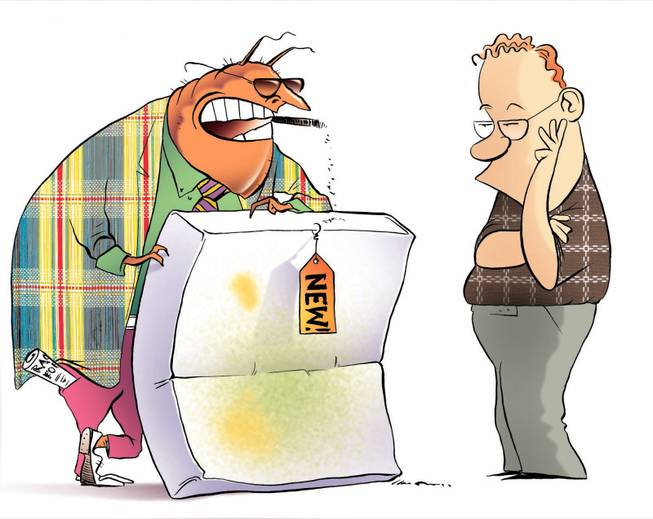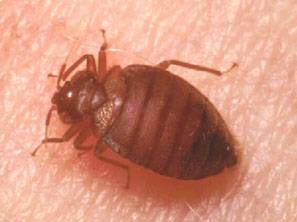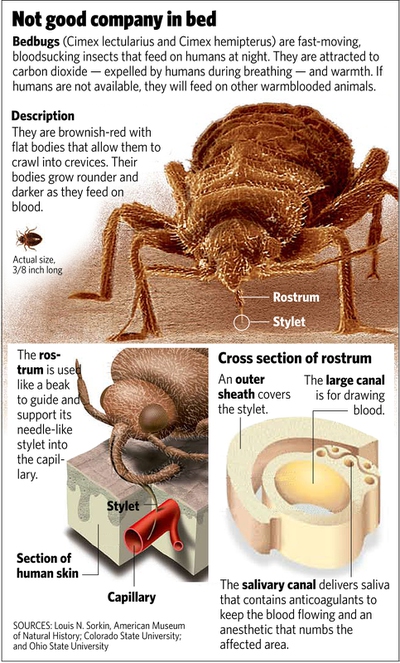Monday, July 6, 2009 | 2 a.m.
Sun Archives
- EPA looks for ways to not let the bed bugs bite (4-14-2009)
- Bedbugs: Dog devoted to pest detection (3-6-2009)
- BED ALERT! (4-4-2008)
- Las Vegas hotels trying not to let those bedbugs bite (7-26-2001)
You’ll wake up one morning and know: Your new mattress is not new.
Bedbugs have been turning up in new mattresses throughout Clark County — or, rather, mattresses advertised as new. In several cases Southern Nevada Health District investigators have found retailers selling used mattresses without proper treatment or disclosure, either because they don’t know it’s illegal or because they absolutely do.
In both circumstances, the outcome is often the same: An unsuspecting buyer wakes with an itch. Concerns about a growing bedbug problem prompted the Health District to draft new regulations governing the sanitation and sale of used mattresses in late 2007. The transfer of slept-on bedding can also mean the transfer of bugs.
Shortly after the regulations were adopted, environmental health specialists such as Jamie Hulbert were out in the field, tracking complaints and inspecting stores. Since February 2008 Hulbert has completed dozens of investigations and written 28 cease-and-desist letters to various furniture stores, rental operations, mattress manufacturers and home-based businesses after she determined they were dealing in used mattresses or components, such as springs and wood forms.
In that time she’s also seen a lot of bedbugs. And she’s developed a routine: Come home, undress and quickly throw clothes into a hot, hot wash cycle. Her process speaks to the problem: Bedbugs are making a national resurgence in part because they travel so well — they burrow, they’re easy to miss, and just one can turn into an infestation — of a house, a hotel, a furniture store. One bad mattress can spoil the whole building.
The economy has made things worse on two fronts: Mattress sellers are looking to cut bottom lines in a tight retail market, which means buying cheaper mattresses from wholesalers and — knowingly or unknowingly — selling used products. At the same time, consumers are looking for discount mattresses and finding deals aren’t really bargains at all, Hulbert said.
For the record, it is perfectly legal to sell used mattresses in Clark County, provided the correct precautions are taken. Although states have different regulations, in Nevada, sellers must basically bake used mattresses in a giant, specialized oven, heating them at 230 degrees for 75 minutes. A treated mattress must be labeled with a bright yellow tag warning consumers that it’s used.
The nearest facility with mattress-cooking capability, however, is hundreds of miles away in Southern California. In other words, Hulbert says, nobody is locally heat-treating used mattresses before selling them.
When Hulbert went to Hotel Furniture Liquidators in February 2008, she determined the company, which specializes in culling furniture from hotels for resale, was selling used mattresses and box springs. She ordered the company to halt all sales of used mattresses, and gave it two days to discard 280 used mattresses on site — an order employee A.J. Muhammad said the store obeyed.
“I’ve heard around town the (bedbug) problem is getting really big,” he said.
The common bedbug, cimex lectularius, starts off the size of a poppy seed and ends up about a quarter-inch long. Newborn nymphs are almost colorless. As they grow, they turn deep brown or dark red — a reflection of their diet. At night they track wafts of carbon dioxide to their sources — often sleeping, breathing humans, for what scientists call a “blood meal,” ingesting six to 10 times their weight.
Bedbugs haven’t been found to carry disease, but that doesn’t make their bites feel any better. And although a few bites might go unnoticed, as a colony grows (one female can produce up to five eggs a day), unknowing sleepers will eventually wake up with a constellation of tiny red welts.
One Clark County resident was bitten so many times he became anemic, Hulbert said. The army of bedbugs was literally draining his blood.
Although bedbugs have turned up in luxury hotels, they disproportionately affect lower-income families — the same people who have the hardest time dealing with infestations. Not having health insurance makes getting treatment difficult, and not having disposable money make it hard to afford exterminators. Moreover, infested furniture often needs to be thrown out, also not an option when you have no money to replace what’s been tossed.
Another solution is to wrap all infested furniture in plastic sheeting or bags, but this is just a stopgap procedure: The bugs can live in wrapped mattresses without a meal for upward of a year, long enough for plastic coverings to deteriorate.
Hulbert visited Silver Mattress Manufacturing in eastern Las Vegas twice in the past two years, most recently last month when she forced the business to throw away a box of springs, alleging they were used. The common signs of used springs: rusted metal or bits of fabric clinging to the springs.
Silver Mattress employee Gilbert Avelar says the springs weren’t used, but that he didn’t want to put up a fight. It was easier to throw away a box than take on the Health District.
Silver Mattress has been in business in Las Vegas for almost 10 years. Avelar says less reputable dealers knowingly buy and sell used mattresses. This has made it hard for Silver Mattress to compete — fraud fire-sales are tough to beat, he said.
“The bedbug thing is really serious right now,” he said. “We try to play by the book.”




Join the Discussion:
Check this out for a full explanation of our conversion to the LiveFyre commenting system and instructions on how to sign up for an account.
Full comments policy